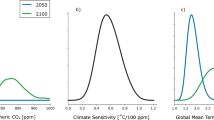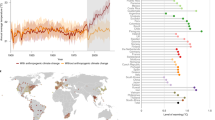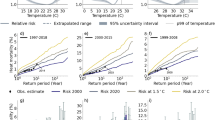Abstract
The summer of 2003 was probably the hottest in Europe since at latest ad 15001,2,3,4, and unusually large numbers of heat-related deaths were reported in France, Germany and Italy5. It is an ill-posed question whether the 2003 heatwave was caused, in a simple deterministic sense, by a modification of the external influences on climate—for example, increasing concentrations of greenhouse gases in the atmosphere—because almost any such weather event might have occurred by chance in an unmodified climate. However, it is possible to estimate by how much human activities may have increased the risk of the occurrence of such a heatwave6,7,8. Here we use this conceptual framework to estimate the contribution of human-induced increases in atmospheric concentrations of greenhouse gases and other pollutants to the risk of the occurrence of unusually high mean summer temperatures throughout a large region of continental Europe. Using a threshold for mean summer temperature that was exceeded in 2003, but in no other year since the start of the instrumental record in 1851, we estimate it is very likely (confidence level >90%)9 that human influence has at least doubled the risk of a heatwave exceeding this threshold magnitude.
This is a preview of subscription content, access via your institution
Access options
Subscribe to this journal
Receive 51 print issues and online access
$199.00 per year
only $3.90 per issue
Buy this article
- Purchase on Springer Link
- Instant access to full article PDF
Prices may be subject to local taxes which are calculated during checkout




Similar content being viewed by others
References
Luterbacher, J., Dietrich, D., Xoplaki, E., Grosjean, M. & Wanner, H. European seasonal and annual temperature variability, trends, and extremes since 1500. Science 303, 1499–1503 (2004)
Schär, C. et al. The role of increasing temperature variability in European summer heatwaves. Nature 427, 332–336 (2004)
Beniston, M. The 2003 heat wave in Europe: A shape of things to come? An analysis based on Swiss climatological data and model simulations. Geophys. Res. Lett. 31, doi: 10.1029/2003GL018857 (2004)
Black, E., Blackburn, M., Harrison, G. & Methven, J. Factors contributing to the summer 2003 European heatwave. Weather 59, 217–223 (2004)
Institut de Veille Sanitaire. Impact sanitaire de la vague chalaire d'aout 2003 en France. Bilan et perspectives. 〈http://www.invs.sante.fr/publications/2003/bilan-chaleur-1103〉 (2003).
Palmer, T. N. & Räisänen, J. Quantifying the risk of extreme seasonal precipitation events in a changing climate. Nature 415, 512–514 (2002)
Allen, M. R. Liability for climate change. Nature 421, 891–892 (2003)
Stone, D. A. & Allen, M. R. The end-to-end attribution problem: From emissions to impacts. Clim. Change (in the press)
IPCC Climate Change 2001: The Scientific Basis: Contribution of Working Group I to the Third Assessment Report of the Intergovernmental Panel on Climate Change (eds Houghton, J. T. et al.) (Cambridge Univ. Press, Cambridge, UK, 2001)
Jones, P. D. & Moberg, A. Hemispheric and large-scale surface air temperature variations: An extensive revision and an update to 2001. J. Clim. 16, 206–223 (2003)
Stott, P. A. et al. Attribution of twentieth century temperature change to natural and anthropogenic causes. Clim. Dyn. 17, 1–21 (2001)
Tett, S. F. B. et al. Estimation of natural and anthropogenic contributions to 20th century temperature change. J. Geophys. Res. 107, doi: 10.1029/2000JD000028 (2002)
Stott, P. A. Attribution of regional-scale temperature changes to anthropogenic and natural causes. Geophys. Res. Lett. 30, doi: 10.1029/2003GL017324 (2003)
Karoly, D. J. et al. Detection of a human influence on North American climate. Science 302, 1200–1203 (2003)
Zwiers, F. W. & Zhang, X. Towards regional scale climate change detection. J. Clim. 16, 793–797 (2003)
Giorgi, F. Variability and trends of sub-continental scale surface climate in the 20th century. Part I: observations. Clim. Dyn. 18, 675–691 (2002)
Johns, T. C. et al. Anthropogenic climate change for 1860 to 2100 simulated with the HadCM3 model under updated emissions scenarios. Clim. Dyn. 20, 583–612 (2003)
Stott, P. A. et al. External control of 20th century temperature by natural and anthropogenic forcings. Science 290, 2133–2137 (2000)
Tett, S. F. B., Stott, P. A., Allen, M. R., Ingram, W. J. & Mitchell, J. F. B. Causes of twentieth century temperature change near the Earth's surface. Nature 399, 569–572 (1999)
Colman, A. & Davey, M. Prediction of summer temperature, rainfall and pressure in Europe from preceding winter North Atlantic ocean temperature. Int. J. Climatol. 19, 513–536 (1999)
Grossman, D. A. Warming up to a not-so-radical idea: Tort-based climate change litigation. Colombia J. Environ. Law 28, 1–61 (2003)
Nakicenovic, N. & Swart, R. Special Report on Emission Scenarios (Cambridge Univ. Press, Cambridge, UK, 2000)
Allen, M. R. & Stainforth, D. A. Towards objective probabilistic climate forecasting. Nature 419, 228 (2002)
Murphy, J. M. et al. Quantification of modelling uncertainties in a large ensemble of climate change simulations. Nature 430, 768–772 (2004)
Allen, M. R. & Tett, S. F. B. Checking for model consistency in optimal fingerprinting. Clim. Dyn. 15, 419–434 (1999)
Allen, M. R. & Stott, P. A. Estimating signal amplitudes in optimal fingerprinting, Part I: theory. Clim. Dyn. 21, 477–491 (2003)
Stott, P. A., Jones, G. S. & Mitchell, J. F. B. Do models underestimate the solar contribution to recent climate change? J. Clim. 16, 4079–4093 (2003)
Coles, S. An Introduction to Statistical Modeling of Extreme Values (Springer, London, 2001)
Acknowledgements
P.A.S. was supported by the Department for Environment, Food and Rural Affairs, D.A.S. by a Wellcome Trust Showcase Award, and M.R.A. received partial support from the NOAA/DoE International Detection and Attribution Group.
Author information
Authors and Affiliations
Corresponding author
Ethics declarations
Competing interests
The authors declare that they have no competing financial interests.
Rights and permissions
About this article
Cite this article
Stott, P., Stone, D. & Allen, M. Human contribution to the European heatwave of 2003. Nature 432, 610–614 (2004). https://doi.org/10.1038/nature03089
Received:
Accepted:
Issue Date:
DOI: https://doi.org/10.1038/nature03089
This article is cited by
-
Increase in MJO predictability under global warming
Nature Climate Change (2024)
-
Record-shattering 2023 Spring heatwave in western Mediterranean amplified by long-term drought
npj Climate and Atmospheric Science (2024)
-
Exploring warm extremes in South America: insights into regional climate change projections through dry-bulb and wet-bulb temperatures
Climate Dynamics (2024)
-
Impacts of compounding drought and heatwave events on child mental health: insights from a spatial clustering analysis
Discover Mental Health (2024)
-
Projected changes in the interannual variability of surface air temperature using CMIP6 simulations
Climate Dynamics (2024)
Comments
By submitting a comment you agree to abide by our Terms and Community Guidelines. If you find something abusive or that does not comply with our terms or guidelines please flag it as inappropriate.



